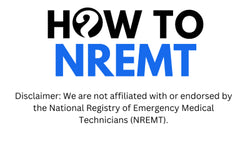Say you’re halfway through the NREMT cognitive exam, and you hit a question that completely stumps you. The scenario looks familiar, but the answer choices all seem wrong or confusing. You freeze for a moment, worried that one bad guess will cost you the exam.
The truth? Guessing strategically is not only acceptable on the NREMT exam, it’s smart. In fact, the very design of the test allows for it. The NREMT exam is built on an adaptive algorithm that measures competency, not perfection. That means you can miss questions and still pass, as long as your overall performance shows that you meet the national standard for entry-level EMTs.
The key is to guess strategically. Instead of panicking, you can use proven methods to narrow your options and make choices that align with emergency medicine best practices.
In this guide, we’ll break down why strategic guessing works, how to apply it during the exam, and the mindset shifts that will help you walk into your test with confidence.
Why Strategic Guessing Works on the NREMT Exam
Before diving into techniques, let’s clarify why guessing isn’t just random luck on this exam.
1. The Nature of Adaptive Testing
The NREMT cognitive exam uses a Computer Adaptive Testing (CAT) format. Unlike traditional exams with fixed question counts and percentage-based scoring, the CAT adjusts difficulty based on your performance. If you answer correctly, you’ll likely get a more challenging question next. If you miss one, the algorithm may present an easier one.
This means:
·Missing a question doesn’t automatically put you on a failing path.
·What matters is the overall pattern of competency you demonstrate.
·Guessing strategically can keep you in the game long enough for the algorithm to recognize your strengths.
2. Competency Over Perfection
The goal of the exam is not to test if you know everything. It’s designed to see if you meet the minimum standard of safe, competent practice as an EMT. Even high-performing students get tough questions wrong. What matters is showing consistent reasoning that aligns with safe and effective patient care.
3. Elimination Improves Odds
Random guessing gives you a 25% chance on a four-option question. But when you use elimination, you can often bump that up to 50% or even 100%. That’s the difference between leaving your score to chance and making an informed choice.
The Psychology of Guessing Under Pressure

Guessing doesn’t just test knowledge; it also tests mindset. Many students trip themselves up not because they don’t know the material, but because they panic when they don’t.
1. Fight Exam Anxiety
When you encounter a tough question, your stress response kicks in. Your heart races, your palms sweat, and you feel pressure to “get it right.” Recognizing this and practicing calming techniques (deep breaths, positive self-talk) keeps your mind clear enough to think logically.
2. Avoid Perfectionist Thinking
Some students believe that missing too many questions means failure. Remember, nobody gets every NREMT question right. The test is designed to push you to your limits. Accepting that guessing is part of the process will help you stay calm.
How to Guess Strategically
Now let’s get tactical.
Here are step-by-step strategies to turn uncertain moments into smart decisions.
Step 1: Read Carefully Without Overthinking
Many wrong answers happen because students skim or misinterpret the question.
Slow down just enough to understand:
·What is the main issue?
·What are they actually asking? (e.g., first step, most important intervention, best response)
Don’t add details that aren’t there. The exam gives you exactly what you need: nothing more, nothing less.
Step 2: Eliminate Incorrect Options
Use a process of elimination to narrow choices.
Ask yourself:
·Does this option contradict standard care (like putting a trauma patient in Trendelenburg)? Eliminate it.
·Does this option address a symptom rather than the cause? Probably not the best choice.
·Is this something outside the EMT scope of practice? If yes, rule it out immediately.
Step 3: Choose the Best Practice
When left with two or more plausible answers, ask:
·Which option reflects patient safety first?
·Which aligns with AHA or NREMT-recognized guidelines?
·Which intervention is the most immediate priority (e.g., airway before circulation)?
In most cases, the safest, guideline-based, patient-centered option is the correct one.
Step 4: Trust Your Choice and Move On
Second-guessing wastes time and drains confidence. Once you’ve applied elimination and reasoning, trust your decision. Obsessing over a single question doesn’t help; the algorithm is scoring your overall ability, not your perfection on one item.
Mindset Tips for the NREMT Cognitive Exam
Strategic guessing works best when paired with the right test-day mindset.
1. Don’t Obsess Over Question Count
The CAT exam can stop anywhere between 110 and 150 questions. A short exam doesn’t mean you passed or failed, and neither does a long one. The algorithm simply stops once it’s confident in your competency.
2. Focus on One Question at a Time
Don’t let a hard question haunt you as you move forward. Each new question is a fresh start.
3. Remember Practical Application
The exam isn’t testing trivia; it’s testing if you can act like a safe, entry-level provider. When in doubt, pick the option that best matches real-world patient care priorities.
4. Review Guidelines Ahead of Time
Many questions are grounded in current AHA guidelines for CPR and emergency cardiovascular care. If you’re familiar with the latest updates, you’ll have a strong advantage when making strategic guesses.
How We Help Students Master Strategic Thinking

At How To NREMT, we know that passing the exam isn’t about memorizing every single fact; it’s about thinking like a provider. That’s why we train our students not just to study, but to reason. Strategic guessing is one of the skills we build into our programs, because it reflects the reality of both the exam and the field.
When you begin NREMT test prep with us, you’ll learn how to recognize patterns, eliminate unsafe choices, and trust your decision-making. These are the exact habits that help students pass on their first attempt, and carry over into safer patient care once they’re on the job.
Join our Full Access Membership for structured study resources, or sign up for Private Coaching and Tutoring to get personalized guidance on mastering test-taking strategies. Together, we’ll help you approach the NREMT cognitive exam with confidence and pass on your first try.

